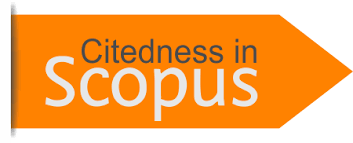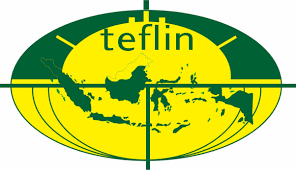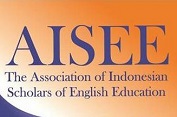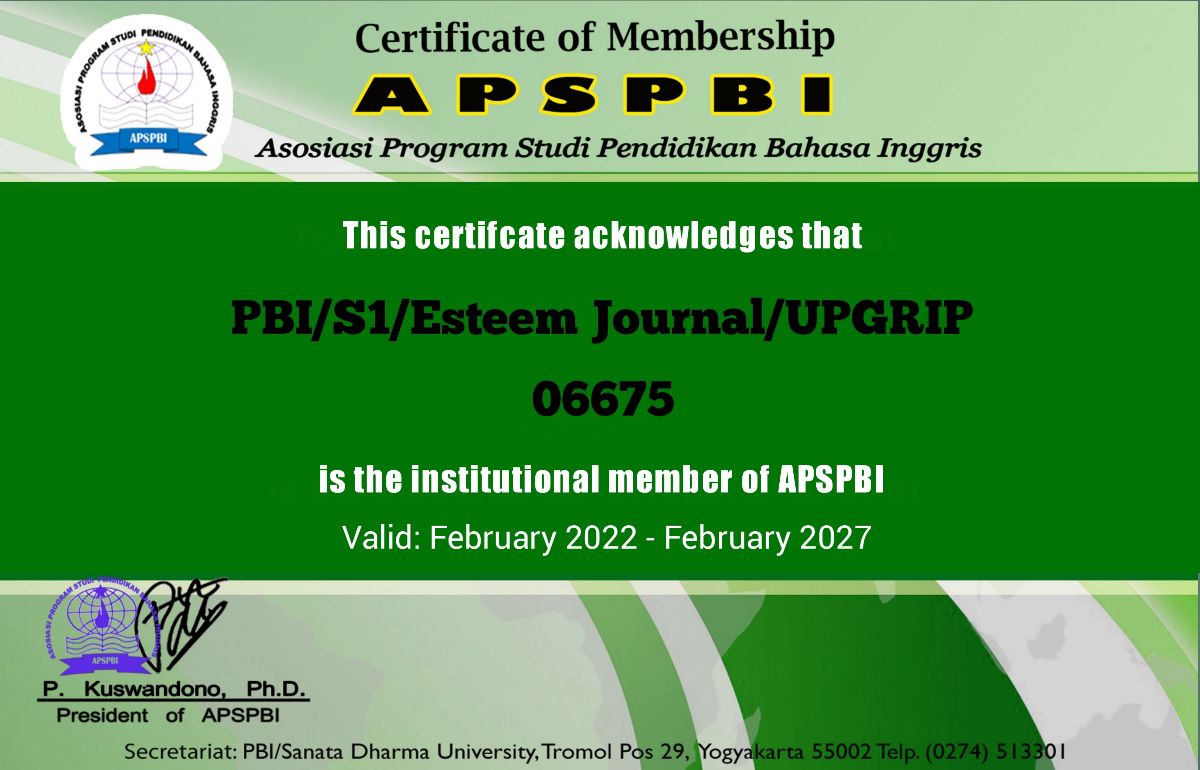A CONTENT ANALYSIS OF ENGLISH LEARNING MODULE BY CUNNINGSWORTH’S THEORY
DOI:
https://doi.org/10.31851/esteem.v7i2.14832Keywords:
Content analysis, English, Learning moduleAbstract
The control over the materials used in the classroom rests with the schools. Because of this, some educational establishments decide to develop their own curricula. When developing the module, schools must follow educational guidelines in addition to ensuring that the learning resources align with the curriculum. This study aims to evaluate and investigate the English curriculum used in one of the middle schools. This study will use a qualitative descriptive research method in conjunction with a qualitative research design. When evaluating an English module for third-grade junior high school students, the Cunningsworth evaluation checklist will offer a comprehensive framework for a general examination and analysis of the module. The research yielded several findings. The linguistic substance of the language style is appropriate for the pupils' grade level. This skill set does not include any writing or listening tasks. The topic analysis indicates that the programme is engaging and exciting, and that there is a significant overlap between the subject matter and the students' daily life. In theory as well as in practice, this research would be helpful. In theory, this study should enhance education, especially in the field of assessing instructional materials for the English language. Additionally, it might support or add to previous findings. It is hoped that this research's practical application will help educators evaluate instructional resources, and English language instructors will find value in the findings. This study examines and assesses English content produced by the school, filling the evaluation gap left by earlier studies that evaluated widely used or education government textbooks. It is expected to assist schools in evaluating their land as a source of instructional materials to facilitate effective instruction.
References
Aryani, D. (2016). Content Analysis on English Module “Bahasa Inggris”. Journal of English Language and Education, 12(1).
Apriyani, L. A., Robiasih, R, H. (2019) Eight grade textbook evaluation by Cunningsworth’s theory. Journal of English Language and Pedagogy, 2(2), 94-103.
Erizar., Azmi, M. N. L. (2017). The Effectiveness of English Teaching Module at Middle Schools in West Aceh. The International Journal of Social Sciences, Vol. 5(3). 333-340
Creswell, J.W. (1994). Research design: qualitative and quantitative approaches. California: SAGE Publications, Inc.
Cunningsworth, A. (1995). Choosing Your Coursebook. Oxford: Heinemann Publishers Ltd.
Gilmore, A. (2007). Authentic materials and authenticity in foreign language learning. Language Teaching, 4(2), 97–118.
Glass, G. V., & Hopkins, K. D. (1984). Statistical Methods in Education and Psychology (2nd ed.). Prentice-Hall.
Hermansyah, Jaya, A., Pratiwi, E., & Fitri, A. (2021). Teacher’s Strategies In Teaching Speaking During Covid-19 Pandemic. Journal of English Education and Teaching (JEET), 5(3), 349–367. https://doi.org/10.56983/ijp.v2i1.483
Jaya, A., Hermansyah, H., & Rosmiyati, E. (2019a). The implementation of project-based learning in increasing speaking achievement and self-confidence. Indonesian Educational Administration and Leadership Journal (IDEAL), 1(1), 4–14.
Miles, M. B., Huberman, A. M., & Saldaña, J. (2014). Qualitative data analysis: A Methods sourcebook. Los Angeles: Sage.
Munfaati, F., Nasihah, M., Ni’mah, U., Senta, A. N., Tsuroyah, N.A. (2022). A Content Analysis of English Teaching Module Entitled “Practical English”. Journal of English for Academic and Specific Purposes, 5(2), 323 - 337.
Nugraha, H., Carnando, G. (2022). Analyzing the Suitability of Cambridge ESL Textbook for Grade IX with K-13. Linguistics English Education and Art (LEEA), 5(2), 272-285
Hutchinson, T., Torres, E. (1994). The Textbook as Agent of Change. ELT Journal, 48(4), 315-328.
Mahmood, K. (2006). The Process of Textbook Approval: A Critical Analysis. Journal Bulletin of Education & Research, 28(1), 1-22.
Rambe, A. L., Zulida, E., Makhroji, Fadlia,Chairuddin, Rahmiati. (2020). An Analysis English Textbook for Second Grade Students at Senior High School Based on Tomlinson’s Principles. Journal of Education, Linguistics, Literature and Language Teaching, 3(2), 14-28.
Rea- Dickens PP, Germaine K. (1994).Evaluation In Canadlin and Widdowson (ed.). Oxford: Oxford University Press.
Richard, J. C., Schmidt, R. (2002). Language Teaching And Applied Linguistics. London: Longman.
Su, S. W. (2012). The Various Concepts of Curriculum and the Factors Involved in Curricula-making. Journal of Language Teaching and Research, 3(1), 153-158
Safitri, M., & Tyas, P. A. (2019). An Analysis of English Textbook Entitled “Bahasa Inggris SMA/MA SMK/MAK Kelas X.” Journal of English Educators Society, 4(1), 17-22
Tok, Hidayet. (2010). TEFL Textbook Evaluation: From teachers‟ perspective. Journal Educational Research and Review, 5(9), 508-517
Tomlinson, B. (2011). Materials Development in Language Teaching. Cambridge: Cambridge University Press.
Wigati, A. A., Maharta, N., Suyatna, A. (2015). Pengaruh Penggunaan Modul Fisika Berbasis Inkuiri Terbimbing Terhadap Minat Dan Hasil Belajar. Jurnal Pembelajaran Fisika, Vol. 3(6), 12.
Wilkinson, D., Birmingham, P. (2003).Using Research Instruments: A Guide for Researchers. London: RoutledgeFalmer
Downloads
Published
Issue
Section
License
Copyright (c) 2024 Viera Safira, Yanti Wirza, Lenny Kristanti, Hana Shadrina, Surya Aulia Sukarman

This work is licensed under a Creative Commons Attribution-NonCommercial-ShareAlike 4.0 International License.
Copyright Notice
Authors who publish with this journal agree to the following terms:
In order to assure the highest standards for published articles, a peer review policy is applied. In pursue of the compliance with academic standards, all parties involved in the publishing process (the authors, the editors and the editorial board and the reviewers) agree to meet the responsibilities stated below in accordance to the Journal publication ethics and malpractice statement.
Duties of Authors:
- The author(s) warrant that the submitted article is an original work, which has not been previously published, and that they have obtained an agreement from any co-author(s) prior to the manuscript’s submission;
- The author(s) should not submit articles describing essentially the same research to more than one journal;
- The authors(s) make certain that the manuscript meets the terms of the Manuscript Submission Guideline regarding appropriate academic citation and that no copyright infringement occurs;
- The authors(s) should inform the editors about any conflict of interests and report any errors they subsequently, discover in their manuscript.
Duties of Editors and the Editorial Board:
- The editors, together with the editorial board, are responsible for deciding upon the publication or rejection of the submitted manuscripts based only on their originality, significance, and relevance to the domains of the journal;
- The editors evaluate the manuscripts compliance with academic criteria, the domains of the journal and the guidelines;
- The editors must at all times respect the confidentiality of any information pertaining to the submitted manuscripts;
- The editors assign the review of each manuscript to two reviewers chosen according to their domains of expertise. The editors must take into account any conflict of interest reported by the authors and the reviewers.
- The editors must ensure that the comments and recommendations of the reviewers are sent to the author(s) in due time and that the manuscripts are returned to the editors, who take the final decision to publish them or not.
Authors are permitted and encouraged to post online a pre-publication manuscript (but not the Publisher final formatted PDF version of the Work) in institutional repositories or on their Websites prior to and during the submission process, as it can lead to productive exchanges, as well as earlier and greater citation of published work (see The Effect of Open Access). Any such posting made before acceptance and publication of the Work shall be updated upon publication to include a reference to the Publisher-assigned DOI (Digital Object Identifier) and a link to the online abstract for the final published Work in the Journal.





























